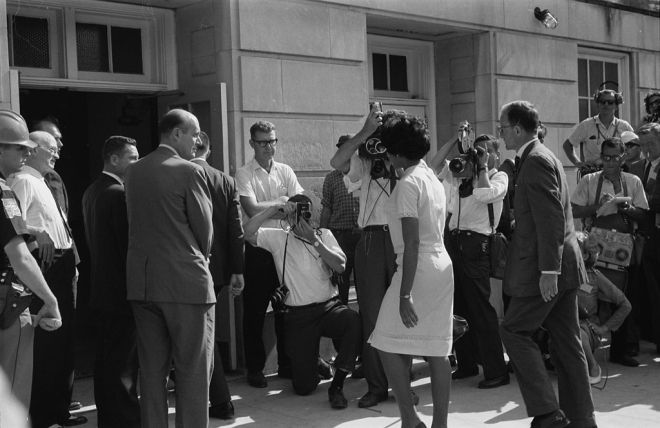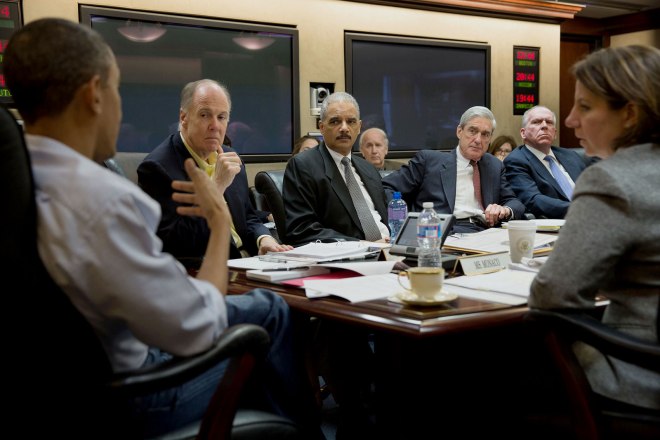On Sept. 22, 2010, President Obama invited the top lawyer in the land, Attorney General Eric Holder, to the White House, along with Lisa Jackson, head of the Environmental Protection Agency, and other Cabinet directors. The agenda: Discuss how to jumpstart the federal Interagency Working Group on Environmental Justice. This was a body formed in 1994 at President Clinton’s request to plan how each federal department would make policies that didn’t further burden people of color and low income. President George W. Bush pulled the plug on the group, but Obama and Jackson, the first African American to lead the EPA, resurrected it.
Holder, also the first African American to hold his position, came out boldly in that meeting in support of the cause. “In too many areas of our country, the burden of environmental degradation falls disproportionately on low-income and minority communities — and most often, on the children who live in those communities,” he said. “Our environmental laws and protections must extend to all people, regardless of race, ethnicity, or socioeconomic status, which is why the Department of Justice is committed to addressing environmental justice concerns through aggressive enforcement of federal environmental laws in every community.”
To that end, Holder volunteered the Justice Department to create a plan for improving enforcement of Title VI of the Civil Rights Act, which bars racial discrimination for any federally funded program in America. Title VI had been enforced when it came to housing, voting, and education to a much greater extent than it had with environmental protection. Holder wanted to change that.
Obama, Holder, and Jackson were of like mind on this synthesis of civil rights and environmental protections. Why? Well, if civil rights strengthen democracy, and environmental laws do the same for our living conditions, then put together, the two create a win-win for the public.
Some of Holder’s top Justice officials were already on board with this, namely Tom Perez, then head of the department’s Civil Rights Division (now head of the Labor Department), and Ignacio Moreno, then head of the Environment and Natural Resources Division. The Justice Department was once filled with lawyers of the same belief system, but many of them were removed during the Bush years, and scandalously. Holder called many of them back; it was a revival.
Obama called Holder back to the White House in Dec. 15, 2010, this time with 16 other Cabinet executives, to formally commit the administration to environmental justice. Speaking there, Holder again emphasized the “aggressive enforcement” of environmental laws to protect America’s most vulnerable communities. “Title VI and the National Environmental Policy Act,” he said, “are powerful tools in our ongoing struggle.”
Today, Holder is planning to step down from his post as soon as the president can name a successor. Civil rights groups have cherished him for his dogged championing of civil rights laws, and his rigorous enforcement of the Voting Rights Act. But as he steps away, it is less clear whether the power he said existed within our civil rights and environmental laws for protecting overburdened communities has proven out.
Holder has called environmental justice “a personal calling.” His sister-in-law, Vivian Malone (now deceased), was one of the two black students attempting to integrate the University of Alabama in 1963 when Gov. George Wallace made his dramatic “segregation forever” stand. She was eventually registered with the help of Nicholas Katzenbach, the deputy who then-Attorney General Bobby Kennedy sent to prevent Wallace from obstructing her path. After graduating, Malone took her first job in the Justice Department’s civil rights division. She went on to work in the EPA as its director of civil rights and urban affairs, and later as the agency’s first director of environmental justice.
It’s no surprise, then, that Holder sees a natural connection between environmental and civil rights protections. He’s pointed to Martin Luther King in many speeches as a symbol of that nexus, pointing out how the civil rights leader was killed while fighting for better work and living conditions for sanitation workers.
Holder’s infantry for forwarding that agenda within the Justice department is the Environment and Natural Resources Division (ENRD), which is responsible for holding companies accountable when they violate laws like the Clean Air and Clean Water acts, and defending the government when implementing those laws. Most iconic of those functions under Holder are the prosecution of BP for the company’s oil spill in the Gulf of Mexico, which has already netted over $4 billion in fines, and its defense of the EPA on greenhouse gas regulations.
Under Holder, the division has expanded its portfolio to include a few victories that have at least led to environmental justice outcomes. You can read about them in the department’s yearly EJ Implementation Progress Reports. Among the examples are 50 agreements the agency has reached with cities under the Clean Water Act to upgrade their sewage and sanitation infrastructure. Over-aged and faulty sewage systems have historically most affected low-income communities of color, at times making the water they drink and bathe in a human health hazard.
There’s also the recent $5.15 billion fine the department lobbed against Anadarko Petroleum, a company responsible for uranium mining and rocket fuel manufacturing operations that have devastated Navajo Nation communities with cancer and other chronic health problems. It’s the largest fine ever levied against a company for an environmental crime. The department has helped achieve similar outcomes for other federal agencies like the Department of Transportation.
But while Holder’s Justice Department has rung up some hefty fines for polluters, it’s been less aggressive about sending those company executives, responsible for the pollution that has caused sickness and death, to jail. Researchers at the Center on Media, Crime and Justice at New York’s John Jay College recently found that over 64,000 facilities are currently in violation of federal environmental laws, but “fewer than one-half of one percent of violations trigger criminal investigations on average.”
According to the report, the Justice Department has only 38 prosecutors in its Environmental Crimes Section. This might help explain why the department was able to win criminal and civil charges against oil company Citgo for violating the Clean Air Act in Corpus Christi, Texas — which exposed hundreds of mostly poor, black and Latino residents to cancer-causing pollutants — but couldn’t win real redress for its victims. Citgo walked off with a $2 million slap on the wrist. Corner drug dealers have been sentenced to far harsher sentences for less harmful crimes.
And here’s the irony: If Holder will be remembered for anything it will be the tremendous strides he’s made on criminal justice reform, notably making it so that people convicted of nonviolent drug crimes aren’t just tossed in the slammer. Those prior practices led to the over-incarceration of black and Latino youth. The bipartisan support Holder earned for his prison and sentencing reforms is unheard of anywhere else in federal government, and climate change advocates would be wise to study his playbook. But the CEOs culpable for far more damaging environmental (and financial) crimes have never had any real reason to worry about filling up prisons like has happened with impoverished youth of color.
But perhaps nothing better illustrates the limitations of Holder’s power than his department’s inability to enforce civil rights laws when it comes to environmental policies. Title VI of the Civil Rights Act is the primary statute available to environmental justice advocates for filing grievances. But its enforcement for Justice attorneys has been the hardest button to button.
I wrote about Title VI’s much-pitied career back in May. There have been a few favorable Title VI settlements and even fewer favorable final decisions. This reality becomes only bleaker when you consider Holder’s personal civil rights dedication. It’s why many activists have called for an environmental justice law — something Al Gore pushed for when he was a senator.
I recently spoke with Mimi Katzenbach, the daughter of Nicholas Katzenbach, the deputy attorney general who helped Vivian Malone register at the University of Alabama back in 1963 and who later served as attorney general under President Johnson. Katzenbach told me she discussed these things with her father before he passed away in 2012, and that he was “adamant” that the current laws were enough to address these problems.
“For my Dad, justice was dynamic,” she said. “In his view, the Constitution does not automatically grant justice to the people; it gives us the means to justice. Justice does not just happen; we must make it happen. The same for environmental justice; we must make it happen, using the democratic, legal tools that we have.”
This has been Holder’s approach, but many of the Justice Department’s staff appeared to be unaware at first that there were tools that fit the environmental-civil rights rubric — as did the EPA. This is likely the result of Bush’s purging of civil rights-minded staff from the department. So much of Holder’s work in this arena has been bringing Justice back up to speed, training staff members on how to identify environmental justice problems and solutions, and developing legal guidances and toolbooks for their reference.
Quentin Pair, a senior attorney in the Environment and Natural Resources Division, recently told me that Holder has not wavered from this kind of grounding for his staff, despite the fact that he lacked an environmental justice law on which to anchor it.
“Getting [Justice department attorneys] to drill down on a particular disadvantaged community can be sometimes pretty subjective,” said Pair. “But it’s important to have attorneys who at least consider [environmental justice] when making judgment calls on whether there’s an injustice. A lot of things might end up looking like an environmental injustice, but if we don’t have a law or regulation behind us to address it, then it is what it is.”
The consequence of a Justice Department that went almost a decade without its civil rights brain trust and moral center is that racial disparities when it comes to environmental pollution didn’t improve.
Holder lamented this in a statement he made this past February commemorating the 20th anniversary of President Clinton’s executive order on environmental justice. “Despite all that’s been achieved, research shows that low-income families and families of color are still more likely than other American families to find themselves living in communities with contaminated water and polluted soil,” he said. “Their neighborhoods are still more likely to be close to industrial waste sites and more vulnerable to the placement of landfills nearby.”
The wool-dyed racism behind such disparities and inequalities is what Holder was getting at when he started his Justice Department tenure by calling us a “nation of cowards” for not dealing with it. But he hasn’t quite been able to wrap his hands around that racism when it comes to environmental injustice. This one handicap does not mean he’s been a failure — he’s had many other victories in other aspects of the law and while up against fierce opposition.
It could just be evidence of the limitations of government, in terms of legal accountability for its history of racism. Or it may be that this is simply the extent of our appetite right now for progressive governance, despite rhetoric to the contrary. Either way, Holder’s resignation is not the last word on it. He deserves credit for, among many things, putting environmental justice back on the Justice Department’s agenda.
As Holder stated in his remarks during the 20th anniversary celebration last winter, “We have achieved demonstrable benefits and effective legal remedies for vulnerable populations that have been adversely impacted by violations of environmental laws. But this work is only the beginning.”





